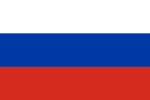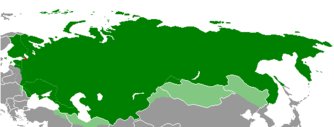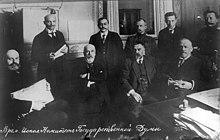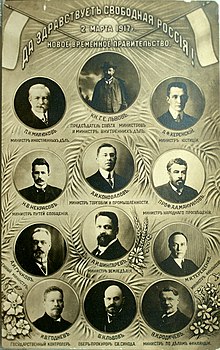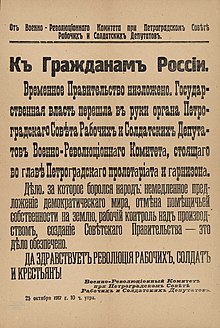Provisional Government (Russia)
|
Временное правительство России Российская республика Russian Provisional Government Russian Republic 1917 |
|||||
|---|---|---|---|---|---|
|
|||||
|
|||||
| Official language | Russian | ||||
| Capital | Petrograd | ||||
| Form of government |
Interregnum (March 15 - September 14) Republic (from September 14) |
||||
| Form of government | Transitional government | ||||
| Head of State and Government |
Georgi Evgenjewitsch Lwow (March 16 - July 21) Alexander Fyodorowitsch Kerensky (July 21 - November 8) |
||||
| surface | 21,799,825 km² | ||||
|
Population - 1916 |
181,537,800 |
||||
| Population density | 8 inhabitants per km² | ||||
| currency | Russian ruble | ||||
| founding | March 15, 1917 | ||||
| resolution | November 7, 1917 | ||||
| National anthem | Otretschomsja ot starowo mira | ||||
| map | |||||
The Russian Provisional Government was the government of Russia from the February 1917 Revolution and the abdication of Tsar Nicholas II , which ended tsarist rule in Russia, until the October Revolution of that year.
Overthrow of the Tsar and formation of the government
The formation of the government was completed on February 28th July. / March 13, 1917 greg. in Petrograd operated a Provisional Committee of the Duma formed from members of the progressive bloc of the Duma under the chairmanship of the Duma President Mikhail Rodzjanko after the previous government had offered to resign. On the same day, representatives of the socialist parties met to form the Petrograd Soviet , which also claimed power. On jul. / March 14th greg. Nicholas II, who had been stopped in Pskov on his way back from the army headquarters to Petrograd, agreed to the formation of a new government by the Duma. Then met on July 2 . / March 15, Greg. Representatives of the Duma Committee and the Executive Committee of the Soviet agreed on an eight-point program as the basis of the future government, which included the election of a constituent assembly . The committee then sent a delegation to Pskov to persuade Nicholas to renounce the throne in favor of his son, Tsarevich Alexei . However, Nikolaus decided to hand over the throne to his brother Grand Duke Mikhail Alexandrovich , who also renounced the following day.
The new government was on July 2nd . / March 15, Greg. proclaimed and their members presented the next day. You belonged to:
| Prime Minister and Home Affairs | Prince Lvov | independent |
| Exterior | Pavel Miliukov | KD |
| War and navy | Alexander Guchkov | Octobrists |
| transport | Nikolai Nekrasov | KD |
| Trade and industry | Alexander Konovalov | KD |
| Finances | Mikhail Tereshchenko | independent |
| education | Alexander Manuilov | KD |
| Chief Procuror of the Holy Synod | Vladimir Lvov | Centrists |
| Agriculture | Andrei Schingarev | KD |
| Judiciary | Alexander Kerensky | TD |
The provisional government first met in the Mariinsky Palace . Its managing director was Vladimir Dmitrievich Nabokov , a member of the Cadet Party with the rank of State Secretary, who coordinated and prepared the meetings.
On the basis of the jointly agreed program, the Soviet called for the support of the government, but at the same time forbade its members to join the government and reserved the right to exercise control over the work of the government. This became known as the dual power system. The chairman of the Petrograd Soviet and Menshevik Nikolos Tschcheidze rejected the post of labor minister intended for him; Kerensky, on the other hand, succeeded at a general assembly of the Soviet in disregarding the ban on entering the government.
April crisis and formation of the coalition government
Due to differences of opinion about the Russian war aims, especially after the publication of the Miliukov note , the government crisis broke out in April and May 1917. This was triggered not least by the return of the Bolshevik party leaders in the spring. Even Lenin returned in early April 1917. supported by the German Reich leadership from his Swiss exile to Russia. They developed lively agitation among the workers and soldiers and in the Soviets. Guchkov and Miliukov resigned and Prince Lvov offered the Mensheviks and Social Revolutionaries to participate in the government. On jul. / May 14th greg. The Soviet decided to accept the offer and lift their ban on government participation. On 5 jul. / May 18th greg. the new government was presented:
| Prime Minister and Home Affairs | Prince Lvov | independent |
| Exterior | Mikhail Tereshchenko | independent |
| War and navy | Alexander Kerensky | SR |
| transport | Nikolai Nekrasov | KD |
| Trade and industry | Alexander Konovalov | KD |
| Finances | Andrei Schingarev | KD |
| education | Alexander Manuilov | KD |
| Chief Procuror of the Holy Synod | Vladimir Lvov | Centrists |
| Agriculture | Viktor Chernov | SR |
| Judiciary | Pavel Pereversev | Mensheviks |
| job | Matwei Skobelev | Mensheviks |
| Post and telecommunications | Irakli Tsereteli | Mensheviks |
| nutrition | Alexei Peschechonov | People's Socialists |
| State control | Ivan Godnew | Octobrists |
| Welfare | Dmitri Shachowskoi | KD |
Juliet uprising and Kerensky takeover
As the new Minister of War, Kerensky urged the opening of an offensive against the Central Powers and thus opposed the First All-Russian Congress of Soviets, which was being held at that time . On jul. / June 29th greg. then began the advance known as the Kerensky Offensive . As the attack began to exhaust itself and a counter-offensive became increasingly threatening, the government tried to counter this by mobilizing soldiers from the Petrograd garrison . But since this provoked strong opposition and was not permitted due to the agreements with the Soviet in March, it opened up the possibility of mass mobilization for the Bolsheviks. On 4 jul. / July 17th Greg. Soldiers of the 1st Machine Gun Regiment and Kronstadt sailors marched to the seat of the Soviet in the Tauride Palace , demanded that the Soviets take power and threatened the arrest of the ministers. Only through the deployment of regiments loyal to the government and the publication of allegations of espionage against Lenin could the July uprising be crushed.
Due to the events and the deteriorating situation on the front (on the 6th . Jul / 19 July . Greg troops began the Central Powers their counter-offensive ) were Prince Lvov and several ministers in July from their positions back; Lvov proposed Kerensky as his successor. Kerensky accepted the offer and subsequently ruled with a rump cabinet. To resolve the political crisis, he called the “Great State Conference” in Moscow in August, and tried to counter the military crisis by appointing Lavr Kornilov as Commander-in-Chief . His demands for the reintroduction of strict military discipline and the simultaneous conspiracy of right-wing circles to establish a military dictatorship led to the Kornilov affair .
Directory and fall
The last few months of the Provisional Government were marked by an increasing loss of power and authority. On jul. / 14 September greg. Kerensky proclaimed the Russian Republic, responding to a key demand of the radical left. 14 jul. / 27 September greg. the "Democratic Conference" began in Petrograd, from which the right and the cadets were already excluded. This issued on September 19 July. / October 2nd greg. a group of five (“Directory”) under the leadership of Kerensky was given the task of managing government affairs and elected a “pre-parliament” from among their number to monitor its work. One of the most important tasks of the Directory was to convene the constituent assembly immediately, which had been postponed several times since March. These plans came into jeopardy when, in October, German troops moved within range of Petrograd and the government began planning their move to Moscow. The election date was finally July 12th . / November 25, 1917 greg. fixed. Thereupon, at Lenin's insistence, the Bolsheviks accelerated their preparations for the uprising.
On jul. / October 22nd greg. the Petrograd Soviet founded the Military Revolutionary Committee ( Milrevkom ), which was originally supposed to organize the defense of Petrograd, but was soon used by the Bolsheviks to prepare for their overthrow (the October Revolution ). On October 22nd, Jul. / November 4, 1917 greg. the Milrevkom ultimately demanded the transfer of command of the troops of the Petrograd military district. On October 24th, Jul. / November 6th greg. the government mobilized the last of its forces to defend it. The next day, the seat of government in the Winter Palace was surrounded by Red Troops, who in the evening issued an ultimatum to the members of the government gathered in the building. At the same time, the 2nd All-Russian Congress of Soviets began its meeting in Smolny . In the morning hours of October 26th, Jul. / November 8th greg. the members of the government (with the exception of Kerensky, who managed to escape) were arrested and taken to the Peter and Paul Fortress , a little later the Bolsheviks announced their takeover.
See also
literature
- Orlando Figes : A People's Tragedy. The epoch of the Russian Revolution from 1891 to 1924. Berlin Verlag , Berlin 1998, ISBN 3-8270-0243-5 .
- Richard Pipes : The Russian Revolution. 3 volumes Rowohlt , Berlin 1992–1993, DNB 552089869 .
Web links
Individual evidence
- ↑ Jörg Baberowski : The meaning of the story. Theories of history from Hegel to Foucault . CH Beck, Munich 2005, ISBN 3-406-52793-0 , p. 16.
